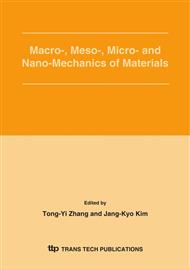p.21
p.31
p.41
p.51
p.59
p.69
p.79
p.87
p.93
Influence of Surface Properties on Microscratch Durability of Aluminum Nitride Semiconductor Processing Component
Abstract:
The effect of the surface properties on the microtribological characteristics of AlN-based electrostatic chuck (EC) for silicon plasma etching was investigated using automatic microscratch testing technique in combination with SEM examination of the scratch track. The scratch testing was performed by applying a progressive indenter load. The scratch failure model varied systematically with the surface properties of AlN. The data of the onset of brittle fracture were used as characteristic features of the AlN failure. It was found that the critical load, Lc, the smallest applied normal load leading to unacceptable damage such as chipping and cracking, increases with decreasing the average grain size, density and fracture toughness of AlN and decreases with increasing the surface roughness and area density of pre-existing polishing damages. The resistance to cohesion and adhesion failure of AlN with 0.1 µm Al2O3 oxide layer on top was stronger than that of the AlN bulk material. The fracture initiation and ductile to brittle transition in AlNAl2O3( 0.1µm) was in form of discontinuous chipping. The results infer the potential of the combination of the scratch data with the material properties for the understanding of the effect of the surface topography on the mechanical properties and chucking performance of AlN-based EC.
Info:
Periodical:
Pages:
59-68
Citation:
Online since:
September 2005
Authors:
Price:
Сopyright:
© 2005 Trans Tech Publications Ltd. All Rights Reserved
Share:
Citation:


